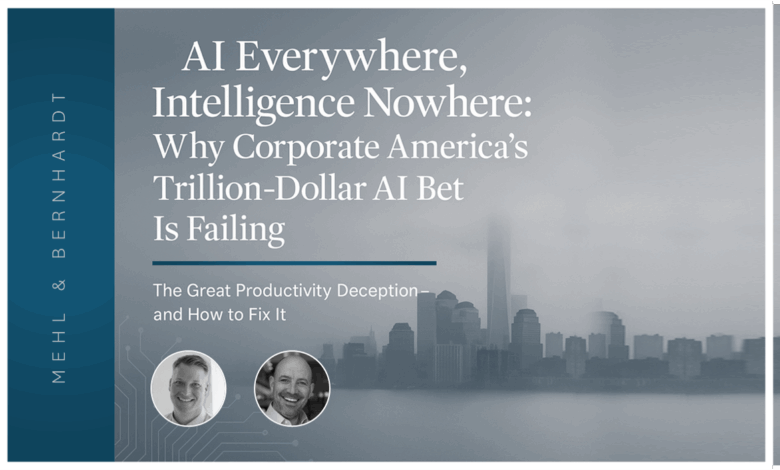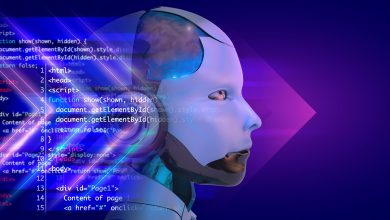
By Prof. Martin Mehl, Founder & CEO, Mentorship Academy, LLC, and Dr. Markus Bernhardt, Principal, Endeavor Intelligence
The Trillion-Dollar Question
Labor productivity is falling across America. U.S. output per worker dropped 1.5% last quarter, while labor costs jumped significantly. Meanwhile, AI adoption has exploded throughout corporate America. Companies are deploying large language models across every business function, investors are betting trillions on digital transformation, yet national productivity metrics aren’t moving upward.
Even Federal Reserve Governor Lisa Cook recently admitted: “AI innovation has yet to lift productivity.” While some might see this as a temporary implementation lag, the mounting evidence points to a more fundamental structural problem. We’re experiencing a productivity plateau that signals a deeper systemic issue.
The current stagnation isn’t a failure of AI’s technical capabilities. The algorithms are increasingly powerful, the models continue improving at unprecedented pace, and the available tools grow more sophisticated daily. However, the overarching problem is that these advanced technologies are being deployed into legacy organizational systems that were never designed for this kind of augmentation.
We Built the Engine but Never Trained the Pilot
Global enterprises have spent trillions on generative AI platforms over the past two years. Yet according to McKinsey’s latest AI survey, only 1% of organizations report scaled, integrated, measurable ROI from their AI investments. The default explanations no longer apply convincingly. Immature technology? AI capabilities have reached remarkable sophistication. Slow adoption rates? Deployment is now widespread across industries.
The problem isn’t access to AI tools. The fundamental issue is organizational fluency with these systems. Companies now rely on employees to use models that generate strategic content, synthesize complex data, and produce analytical insights. But most workers lack the precision, judgment, and workflow adaptation skills necessary to make those tools genuinely productive.
We’ve delivered raw intelligence without proper integration. We’ve provided immense computational power without developing human fluency to harness it effectively.
The Education Infrastructure Failure
While this productivity gap manifests as a corporate training failure, its roots run much deeper into our educational infrastructure. AI technology evolves and improves in quarterly cycles. Universities and educational institutions revise their curricula in multi-year cycles, creating a fundamental mismatch.
The World Economic Forum projects that 40% of core job skills will change significantly by 2030. Yet most education systems continue to reward information retention and standardized approaches. These structures were built for stable knowledge domains, not continuous transformation and adaptation.
The OECD found that fewer than 6% of corporate training programs include substantive AI capability building, even though AI is already reshaping approximately one-third of global job functions. We are systematically credentialing people into professional irrelevance.
The Real Problem: Architecture, Not Adoption
Examine the typical AI implementation pattern across organizations. AI tools get deployed in functional silos: sales departments receive forecasting algorithms, HR installs chatbot systems, marketing teams buy personalization engines. But there’s no cross-functional fluency, no integration into existing workflows, and no connective tissue linking these tools to strategic business outcomes.
This approach creates “AI islands” – disconnected capabilities that actually reduce overall organizational intelligence through information asymmetries and workflow friction. The primary barrier to scaling AI effectiveness is no longer technical limitations. It represents a fundamental challenge of organizational design and systems thinking.
Companies desperately need AI orchestration layers, not mere technology accumulation. The enterprise architecture imperative is clear: treat artificial intelligence as infrastructure, not as isolated tools. You wouldn’t build separate power grids for each department.
Winners will architect “cognitive fabrics” – interconnected AI systems that create compound intelligence effects across the entire organization.
The Measurement Fallacy: Literacy vs. Fluency
Our central measurement error has been mistaking basic literacy for genuine fluency. Traditional training approaches focused on easily tracked metrics like video completion rates and quiz scores. These completion metrics felt like meaningful progress but never actually touched real performance outcomes.
True AI fluency is messier and more complex to measure. It requires sophisticated abilities including the capacity to frame questions that guide AI models toward genuinely usable output. Workers must evaluate AI-generated content for subtle distortions, biases, or hallucinations that could mislead decision-making.
Additionally, fluency demands skills to transform raw AI output into actionable documents, strategic plans, and operational decisions. Professionals need judgment to recognize when AI is the wrong tool for specific situations. They must design prompt sequences that build systematically toward complex analytical goals.
Perhaps most critically, workers need to navigate the ethical and bias implications of AI-assisted decision-making processes.
The Cognitive Divide: The New Competitive Advantage
While digital literacy remains an essential foundation, the future workforce must build far beyond basic technical skills to become truly cognitively adaptive. We are attempting to run a 2030 economy using 1990s human cognitive architecture. This fundamental mismatch won’t sustain competitive performance much longer.
The most significant capability gap will define market leaders in the AI era: cognitive adaptability. AI flattens traditional information asymmetries but simultaneously amplifies reasoning asymmetries between organizations and individuals. It floods decision-makers with options, data streams, and analytical outputs, but doesn’t inherently teach better problem-framing, assumption-questioning, or ambiguity navigation.
Cognitive fluency becomes the new literacy, defined by the ability to answer critical questions in real time: Can workers parse meaningful signals from overwhelming noise? Can they apply sound judgment when AI systems offer confident but fundamentally incorrect answers? Can they integrate technical, ethical, social, and organizational factors effectively in real-time decision-making situations?
Without cognitive readiness, digital access alone proves insufficient for competitive advantage.
The Strategic Framework: Building Fluency at Scale
To transition from isolated “AI islands” toward a genuine “cognitive fabric,” organizations must replace their disconnected technology initiatives with integrated fluency development systems. The strategic goal is architecting comprehensive systems where AI functions as connective tissue between three critical organizational functions: employee training, skills assessment, and continuous professional growth.
This transformation requires a profound shift in approach and mindset. Effective training must evolve beyond generic courses toward structured progression through guided practice within actual work flows. Assessment systems must move from tracking course completions to evaluating the quality of real AI-assisted outputs and analyzing employee decision patterns.
Continuous support becomes essential through fostering cultures of experimentation and creating safe learning environments. These “medical residency” style development programs allow professionals to hone advanced skills on high-stakes scenarios without real-world organizational risk.
By weaving training, assessment, and support elements into seamless operational systems, organizations can finally stop measuring superficial literacy and start cultivating measurable fluency that drives genuine performance improvements.
The Urgency Factor: Why Timing Is Everything
Organizations that begin building comprehensive AI fluency today will develop compounding competitive advantages over those that delay strategic investment. Each month of superior AI collaboration creates incremental performance gains that accumulate into significant market advantages over time.
More importantly, the foundational skills required for AI fluency build systematically upon each other. Organizations that start later will need to compress learning timelines, likely sacrificing depth and retention for speed. This rushed approach typically produces superficial capabilities rather than genuine fluency.
Customer expectations are already shifting rapidly to accommodate AI-enhanced service levels across industries. Organizations unable to meet these evolving expectations will find themselves increasingly disadvantaged, regardless of their other operational capabilities or market position.
The window for gradual, comfortable adoption is closing rapidly.
The Path Forward: From Measurement to Mastery
The fundamental question facing organizations is not whether they will eventually need comprehensive AI fluency capabilities – that outcome is inevitable given competitive pressures. The critical question is whether they will build these essential capabilities strategically, when they have sufficient time to develop them properly, or reactively under competitive pressure that forces rapid, potentially ineffective responses.
Organizations that recognize AI fluency as a strategic imperative and invest accordingly will actively shape the future direction of their industries. Those who continue mistaking basic literacy for genuine fluency will find themselves increasingly irrelevant in an AI-augmented competitive landscape.
The transformation begins with recognizing that we’ve been measuring the wrong performance indicators entirely. The moment organizations shift focus from literacy metrics to fluency development, they don’t just follow future trends – they begin actively building the competitive future they want to inhabit.
About the Authors:
Prof. Martin Mehl is Founder & CEO of Mentorship Academy, LLC, and Scholar-in-Residence/Faculty in the Communication Studies Department & Orfalea College of Business at California Polytechnic State University, San Luis Obispo. He is a leading researcher in digital fluency and organizational transformation, focusing on the intersection of technology adoption and human capability development.
Dr. Markus Bernhardt is Principal at Endeavor Intelligence, specializing in enterprise AI strategy and implementation. His research and consulting work focuses on identifying and overcoming the structural and organizational barriers that prevent companies from achieving scalable, measurable returns on their AI investments.



